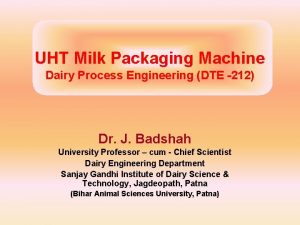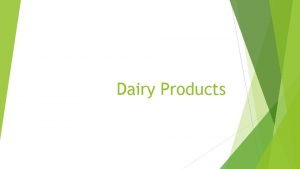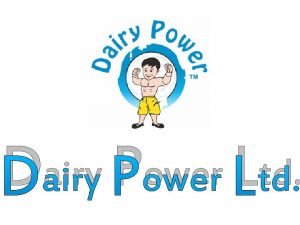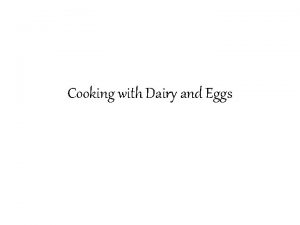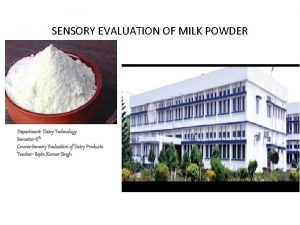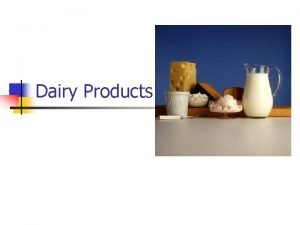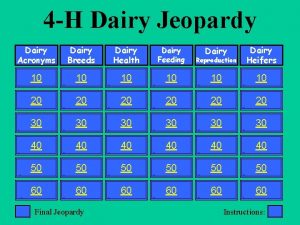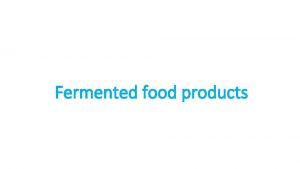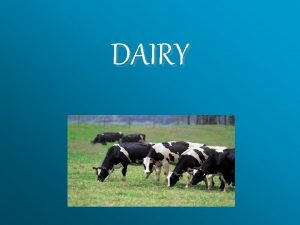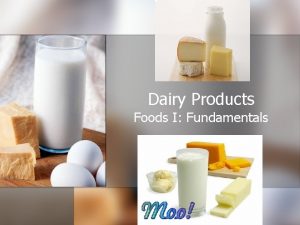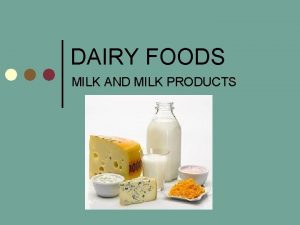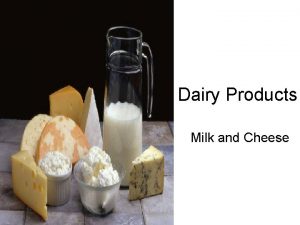Dairy Products Learning Targets I can explain the

















- Slides: 17

Dairy Products Learning Targets: Ø I can explain the different ways milk is processed. Ø I can categorize the different types of concentrated/condensed milks. Ø I can identified the different cultured dairy products according to their characteristics. Ø I can properly and safely use a variety of milk-based products. 1

Dairy Products Dairy products include… Milk from: cows; 3. 5% milkfat, 8. 5% milk solids, & 88% water. goats; 4. 1% milkfat, 8. 9% milk solids, & 87% water. sheep (ewe); 7. 9% milkfat, 11. 4% milk solids, & 80. 7% water buffalo; 7. 5% milkfat, 10. 3% milk solids, & 82. 2% water Products made from the milk from animals: Cream Yogurt Sour cream Concentrated Milks Cultured Dairy products Butter Cheese 2

Dairy Products Milk • Popular beverage • An ingredient in many dishes Milk Provides • • Texture Flavor Color Nutritional value Nutritional Value of Milk ~ one of the highest nutrient containing drinks. • • Protein Vitamins: vitamin A, vitamin D, vitamin B-12, riboflavin Minerals: calcium, potassium, phosphorus, niacin. Lactose: milk sugar 3

Dairy Products Types of Milk: • Whole milk • • • Comes from the cow. 88% water, 3. 5% milk fat, 8. 5% other milk solids (protein, lactose, and minerals). Milk grades include A, B or C; grades are based on the bacterial count in the milk. Grade A has the lowest bacterial count. Grades B & C are safe but not used in commercial/retail use. Fresh whole milk must be processed. Milk is not consumed in it’s raw state. 2% milk 1% milk Skim Milk Lactose-Free Milk Almond Milk 4

Dairy Products Processing Techniques • Pasteurization Ø Ø Ø Grade A milk must be pasteurized prior to retail sale. Destroys the enzymes that cause spoilage. Pasteurization increasing the shelf life of the milk. The nutritional value is not really affected by pasteurization. Process involves: 1. Heat the milk to a high temperature for a sufficient length of time to destroy pathogenic bacteria. 2. Hold the milk at a temperature of 161 degrees F for 15 seconds. • Ultra-pasteurization Ø Ø Ø The process in which milk is heated to a very high temperature (161 degrees F) for a very short time (2 -4 seconds) in order to destroy all bacteria. Increases the shelf life of the product. Used with whipping cream and individual creamers. • Ultra-High-Temperature Processing (UHT) Ø Ø Ø Milk is heated and held at a temperature of 280 – 300 degrees F for 2 – 6 seconds. The milk is immediately packed into sterile containers under sterile conditions and sealed to prevent bacteria from entering the container. Unopened UHT milk can be stored without refrigeration for up to 3 months. Chill the milk before using. The milk must be refrigerated after it is opened. UHT processed milk has a slightly cooked taste, has not significant effects on the nutritional value of the milk. 5

Dairy Products Processing Techniques (cont. ) • Homogenization Ø Ø The process in which the fat globules in whole milk are reduced in size and is dispersed throughout the liquid. This process prevents the fat from clumping together and rising to the surface as a layer of cream. The milk and milk fat do not separate. Milk that is sold commercially is homogenized. Homogenized milk has a whiter color, is uniform in its consistency, and has a richer taste. • Milk fat Removal Ø Ø Whole milk can be spun (centrifuge) to remove all or a part of the milk fat. This process results in a reduced-fat, low-fat and nonfat milk. § § § Reduce or less-fat milk = milk with no more than 2% milk fat. Low-fat milk = milk with no more that 1% milk fat. Nonfat or skim milk = milk with no more than. 5% milk fat. • Storing Milk Ø Ø Must be refrigerated at or below 41 degrees F. Keep containers closed; milk can pick up odors. & flavors. Milk is packaged in opaque containers = sunlight will break down the riboflavin (nutrient) in the milk. Do not freeze milk. 6

Dairy Products Concentrated Milks • • • Products that are produced by using a vacuum to remove all or part of the water from the whole milk. These products have a high concentration of milk fat and milk solids. Concentrated milk products have an extended shelf life. Types of Concentrated Milks • Evaporated Milk 1. This process removes 60 % of the water from whole, homogenized milk. 2. The concentrated liquid is canned and heat-sterilized. 3. Evaporated milk has a cooked flavor and darker color. 4. Requires no refrigeration until it is opened; stored in a cool place. 5. Can be reconstituted with an equal amount of water and used like whole milk for cooking and drinking. 6. Can purchase evaporated skim milk; uses the same process but with skim milk. • Sweetened Concentrated Milk 1. This process removes 60 % of the water from whole, homogenized milk. 2. Has large amount of sugar (40 -50%). 3. The concentrated liquid is canned and heat-sterilized. 4. The sugar and canning process darkens the milk and adds a caramel flavor. 5. Can not substitute for whole milk or evaporated milk, because of its sugar content. 6. Used in desserts and confections food items. • Dry Milk Powder 1. All the moisture is removed from pasteurized milk. 2. Can be made from whole, nonfat, and buttermilk. 3. Can be stored for a long time with out refrigeration. 4. Powdered milks can be reconstituted and used like fresh milk. 5. The milk power can be added to the dry ingredients, and the liquid to reconstitute, can be added to the liquid ingredients in a recipe. 7



Cream • • • Dairy Products A rich liquid milk that contains at least 18% fat. Must be pasteurized or ultra-pasteurized. May be homogenized. Has a slightly yellow or ivory color. Is thicker than milk. These products have a high concentration of milkfat and milk solids and an extended shelf life. Used in cooking to give flavor and body to sauces, soups and desserts. Whipping cream contains not less than 30% milk fat. Can be whipped into a stiff foam and used in pastries and desserts. Ultra-pasteurized creams be kept for 6 -8 weeks in the refrigerator (41 degrees F). Keep away from strong odors and bright lights; can negatively affect their flavor. Types of Creams • Half-and-half • Light Cream, Coffee Cream, and Table Cream • Light Whipping Cream and Whipping Cream • Heavy Whipping Cream and Heavy Cream 1. 2. 3. 4. A mixture of whole milk and cream. Contains 10% - 18% milkfat. Served with cereal and coffee. Does not have enough fat to whip into a foam. 1. Contains between 18% - 30% milkfat. 2. Used in baked goods, soups, with coffee, fruit and cereal. 1. Contains between 30% -36% milkfat. 2. Used for thickening and enriching sauces and ice cream. 3. Can be whipped into a foam and used as a dessert topping. 4. Can be made and folded into custards or mousses to add flavor and lightness to the product. 1. Contains not less than 36% milkfat. 2. Whipped easily and hold the whipped texture longer than the other creams. 3. Must be pasteurized. 4. Rarely homogenized. 5. Used for thickening and enriching sauces and ice cream. 6. Can be whipped into a foam and used as a dessert topping. 7. Can be made and folded into custards or mousses to add flavor and lightness to the product. 10

Chocolate Mousse Recipe 2 servings Ingredients 2 ounces bittersweet chocolate, chopped 2 egg yolks, beaten 1 -3/4 teaspoons sugar pinch of salt 2 egg whites ¼ cup and 2 tablespoons heavy cream Directions 1. Melt chopped chocolate in a double boiler. Stir occasionally until mostly melted, then remove from heat, and stir until smooth. Set aside to cool slightly. 2. In a separate bowl, whip heavy cream to medium stiff peaks, but do not allow it to become grainy. Set aside. 1. In a separate bowl, whip egg whites with salt until soft peaks form. Sprinkle in the sugar, and continue whipping to medium stiff peaks. Fold in egg yolks, using a rubber scraper. 2. Using a rubber scraper, gently fold in the melted chocolate until completely incorporated, then gently fold in the whipped cream until evenly blended. 3. Spoon into dessert cups, and chill until firm, about one hour. 4. Garnish and serve. 11

Dairy Products Cultured Dairy Products • • They are made by adding specific bacterial cultures to a fluid dairy product. The added bacteria converts the milk sugar (lactose) into lactic acid; giving these products their body and tangy flavors. The lactic acid helps to retard the growth of undesirable microorganisms. Cultured products are PHF; keep refrigerated (below 41 degrees F). Types of Cultured Dairy Products • Buttermilk • Sour Cream Historically, it was the liquid that was left over after churning the cream into butter. 2. Today, buttermilk is made by adding a culture (called streptococcus lactis) to fresh, pasteurized skim or low-fat milk. 3. Produces a tart milk with a thick texture. 4. Used in beverages and in baked goods. 1. Produced by adding a culture (called streptococcus lactis) to pasteurized homogenized light cream. 2. Produces a white, tangy gel with a distinct flavor. 3. Used as a condiment and baked goods. 4. Sour cream must have a milkfat content of not less the 18%. • Crème Fraiche • Yogurt 1. 2. 3. 4. 5. A cultured cream popular in French Cuisine. Similar to sour cream; it is thinner and richer than sour cream. Has a tangy flavor. Is used in soups and sauces; especially with poultry, rabbit and lamb dishes. Can be whipped into a foam and used as a dessert topping. 1. A thick, tart custard type product made from milk (whole, low-fat, or nonfat) with an added cultured bacteria. 2. May contain a variety of sweeteners, flavorings and fruits. 3. Usually eaten as is. 4. May be used in baked products, salad dressings and frozen desserts. 5. Used in may Middle Eastern Cuisines. 12

Making Buttermilk in a Pinch Method # 1 Ingredients 8 fl. oz. whole milk ½ fl. Oz. white vinegar or lemon juice 1 clean quart glass jar Directions 1. Boil two cups of water. 2. Pour the boiling water in the quart jar to sterilize it. Cover tightly and shake it around so that the hot water reaches all parts of the jar. Discard water. 3. Combine the whole milk and vinegar (or lemon juice) in a sterilized jar. 4. The mixture should begin to curdle in 15 minutes. 5. Refrigerate. 6. Stir well before using. Method # 2 Ingredients 2 fl. oz. whole milk 6 fl. oz. plain yogurt 1 clean quart glass jar to all in a Directions 1. Boil two cups of water. 2. Pour the boiling water in the quart jar sterilize it. Cover tightly and shake it around so that the hot water reaches parts of the jar. Discard water. 3. Combine the whole milk and yogurt sterilized jar. 4. The mixture should begin to curdle in 15 minutes. 5. Refrigerate. 6. Stir well before using. Buttermilk Biscuit Lab: 1. Write the buttermilk biscuit recipe in a formula format. 3. Complete a grocery list. 4. Use your homemade buttermilk in your recipe. 13

Homemade Buttermilk Ingredients 4 cups water (70 -80°F) 1 1/3 cups non-fat dry milk powder 1 cup store-bought buttermilk (70 -80°F) 1 clean quart glass jar Directions 1. Bring 5 cups water to a boil. 2. Remove 1 cup of water and pour it into the glass jar to sterilize it. Cover tightly and shake it around so that the hot water reaches all parts of the jar. Discard water. 3. Allow the remaining 4 cups of water in the pan to cool slightly, then stir in the non-fat dry milk powder; stir until dissolved. 4. Remove 1 cup commercial buttermilk from the refrigerator and allow to come to room temperature. 5. When the boiled water/milk powder cools to 70 -80°F, stir in the room temperature buttermilk. 6. Cover the jar with cheesecloth (do not cap). Set aside until the mixture thickens (about 12 -18 hours). Cover tightly and refrigerate until needed. 14

Butter General information: • • A fatty substance produced by agitating or churning. Used for sauces, breads and pastries. Must contain at least 80% milkfat, not more than 16% water and 2 -4% milk solids. May or may not have salt. Firm when chilled and soft when at room temperature. Melts at 93 degree F. Smoking point at 260 degrees F. Types of Butter Salted 1. Has up to 2. 5% salt added. 2. Effects the flavor and increases the keeping qualities. 3. The salt content needs to be considered when used for baking. European-Style butter 1. 2. 3. 4. 5. Contains more milkfat than regular butter; 82 -86% milkfat. Very little or no salt is added. Churned from cultured cream. Has an intense buttery flavor Can be substituted for regular butter in baking and cooking. Whipped Butter 1. Made by incorporating air into the butter. 2. Increases the volume and spreadablility. 3. Can become rancid very easily (when the fats breakdown). Results in an off-flavor and loss of nutritional value in the butter). Clarified Butter 1. Has the water and milk solids removed by a process called clarification. 2. Procedure for clarifying butter. 15

The Process of Clarifying Butter: 1. Slowly warm the butter in a saucepan over low heat without boiling or agitation. As the butter melts, the milk solids rise to the top as a foam and the water sinks to the bottom. 2. When the butter is completely melted, skim the milk solids from the top. 3. When all the milk solids have been removed, ladle the butterfat into a clean saucepan. Be very careful to leave the water in the bottom of the pan. 4. The clarified butter is now ready to use. Ø Ø One pound of whole butter will yield about 12 ounces of clarified butter; yield about 75%. Clarified butter will keep for a long period of tie in the freezer or refrigerator. Grading Butter 1. Not mandatory, but most processors test and grade their butters. 2. Grades: USDA Grade AA: superior quality, fresh, sweet flavor and aroma, smooth, creamy texture, good spreadability. USDA Grade A: very good quality pleasing flavor and fairly smooth texture. USDA Grade B: standard quality, made from sour cream, has an acceptable flavor but lacks the flavor, texture and body of the other grades. This grade is most often used in the manufacture of foods. 4. Storing Butter Prone to rancidity; harsh bitter taste and deep yellow to brown color. Should be well wrapped and stored at temps between 32 – 35 degrees. Unsalted butter is best kept frozen until needed. If packaged correctly, will keep for up to 9 months a t temps of 0 degrees F. 16

Margarine General information: • • • Is NOT a dairy product. Used for cooking, baking and table service. Comes from animal or vegetable fat or a combination of both. Things added include: flavorings, colorings, emulsifiers, preservatives and vitamins. Goes through a process of hydrogenation; firmed or solidified by being exposed to hydrogen gas at a very high temperature. The firmer the margarine the greater the degree of hydrogenation. Has 80% fat and 20% water. Does not match the flavor of butter. Comes in tubs or sticks, diet or specialty blends. Margarine in tubs has more water and whipped air; can not be substituted for regular margarine and butter in cooking. 17
 Writing learning targets
Writing learning targets Agonist antagonist muscles
Agonist antagonist muscles Cross projection sketch
Cross projection sketch Knowledge targets
Knowledge targets Learning targets knowledge, reasoning, skill product
Learning targets knowledge, reasoning, skill product Learning target
Learning target Packaging machine dairy products
Packaging machine dairy products Introduction of dairy
Introduction of dairy Frozen milk products
Frozen milk products Dairy power dahi
Dairy power dahi Principles of milk cookery
Principles of milk cookery Sensory evaluation of dairy products
Sensory evaluation of dairy products Nn tart
Nn tart Functional vs innovative supply chain
Functional vs innovative supply chain Pepsi marketing mix
Pepsi marketing mix Cuadro comparativo e-learning m-learning b-learning
Cuadro comparativo e-learning m-learning b-learning Objectives of warehouse operations
Objectives of warehouse operations Racial etiquette region
Racial etiquette region






